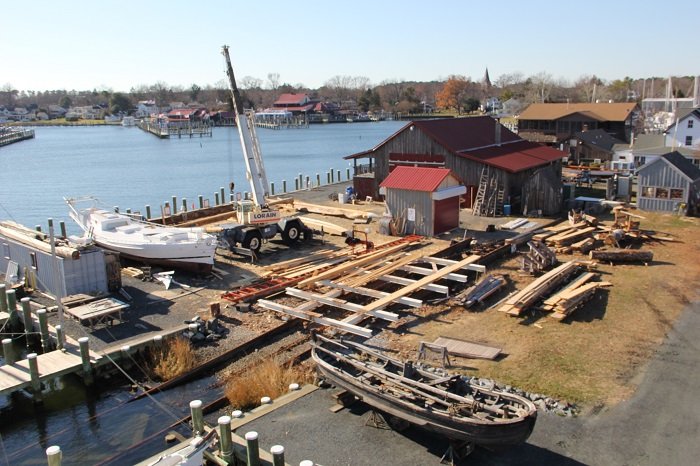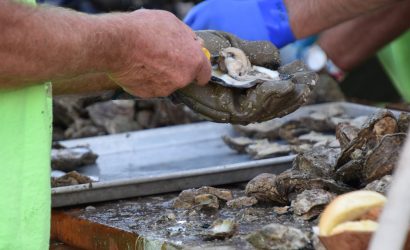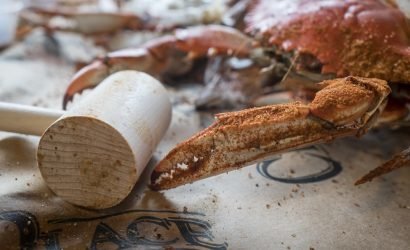Upon arriving at the Chesapeake Bay Maritime Museum, located in St. Michaels, one may think that the welcome center is the actual museum, but the entire campus is a living, working and breathing museum for everyone to enjoy.
In total, the campus stretches over 18 acres and includes 16 buildings and landmarks for visitors to peruse. One of these notable structures is the Working Boatyard where guests can watch and interact with real shipwrights as they restore and build wooden boats. Their current project includes the complete rebuilding of the Edna E. Lockwood, which was originally built in 1889 by John B. Harrison on Tilghman Island. The Edna E. Lockwood is the last example of an oystering vessel known as a bugeye. Constructed during the heyday of the Chesapeake oyster industry, bugeyes were sailboats designed to pull heavy, efficient oystering tools known as dredges while under sail. The shipbuilding crew is about halfway through the expected two-year project.
Another feature to this museum that should not be missed is the Hooper Strait Lighthouse, which was built in 1879 and is one of the four surviving Chesapeake Bay screw-pile lighthouses in the state of Maryland. This particular lighthouse was actually the second lighthouse erected at the entrance to Tangier Sound after the original structure fell captive to an ice storm in 1877. The original lens, lamp and fog bell were salvaged and used to rebuild the second version, which was manned by keepers until 1954, at which point it became automated and boarded up. In the 1960’s, the Coast Guard began to remove lighthouses in order to cut maintenance and to prevent vandalism. It was at this time that the Chesapeake Bay Maritime Museum arranged with the Historical Society of Talbot County and the federal government to have the house moved to its campus. In order to move the house, the building was sliced in half at its eaves, and the two pieces of the house were barged to St. Michaels, where they were reassembled on a newly constructed foundation.
We would be doing our readers a real disservice if we didn’t mention the newest building on campus called the Steamboat Building, which houses a true history of life and culture on the Chesapeake Bay. Artifacts include an original Chris-Craft Boat and skipjacks that were originally used for fishing and oyster dredging on the Chesapeake Bay, in addition to antique oyster dredging tools, maritime flags and audio clips from a time that once was.
Other Historical Structures Include:
- 1888 Point Lookout fog bell tower
- Three other history houses, which are all contributing structures to a National Register District
- 1933 cannery warehouse built on pilings along the waterfront, which was constructed from pieces of an earlier steamboat/railroad terminal
- 1885 Eagle House, once the home of a steamboat captain
- 1880 Tolchester Beach Bandstand
- Mitchell House (circa 1840), a small cottage once owned by free black Peter Mitchell and Eliza Bailey Mitchell, sister to Frederick Douglass
The Chesapeake Bay Maritime Museum is so much more than an amazing collection of Chesapeake Bay culture and historic sailing vessels. It is set on a park-like stretch of the Chesapeake Bay that is perfect for day trips, social events and even weddings. Be sure to stay tuned in with the year-round museum events perfect for water lovers of all ages. Notable events during the summer season include sailboat races on Wednesday evenings and log canoe races on Saturday morning. Mark your calendar for their 4th of July festivities that include a truly entertaining swing band and fireworks over the river!
For more information about the Chesapeake Bay Maritime Museum and to plan your next trip, please visit their website and stay connected with their social channels. Happy travels, day trippers!
213 North Talbot Street | St. Michaels, MD 21663 | 410-745-2916 | Website | Facebook | Instagram | YouTube | Twitter









